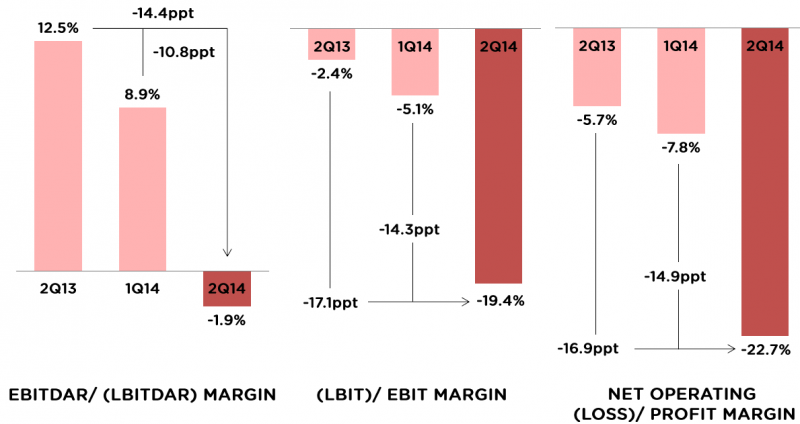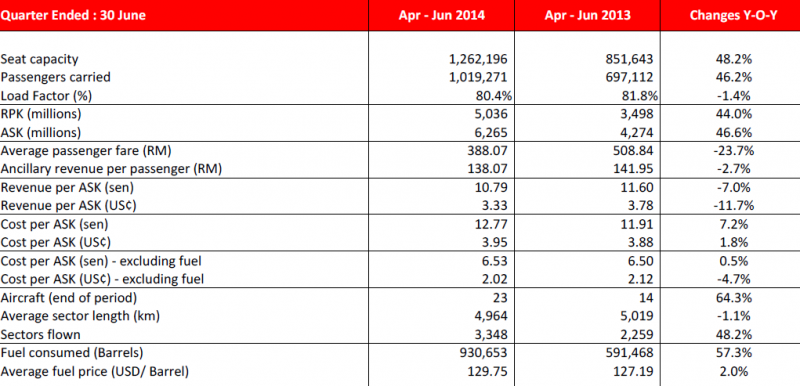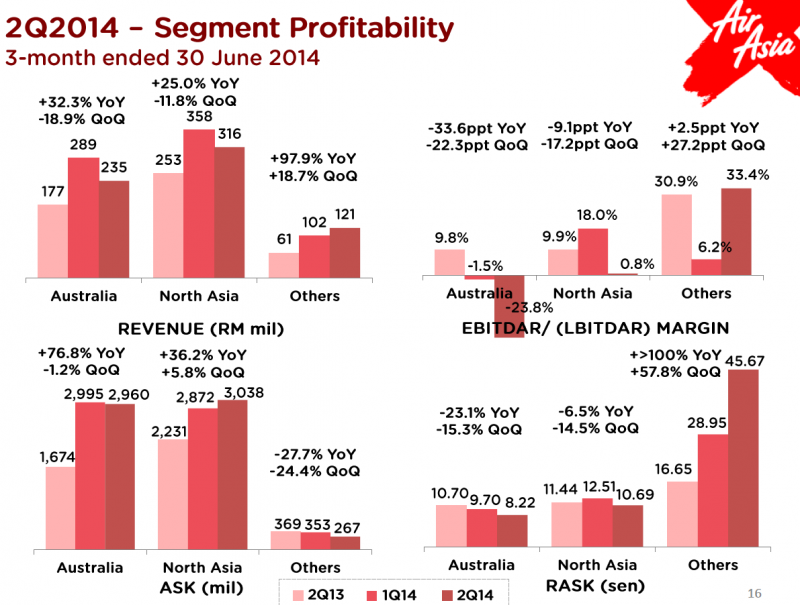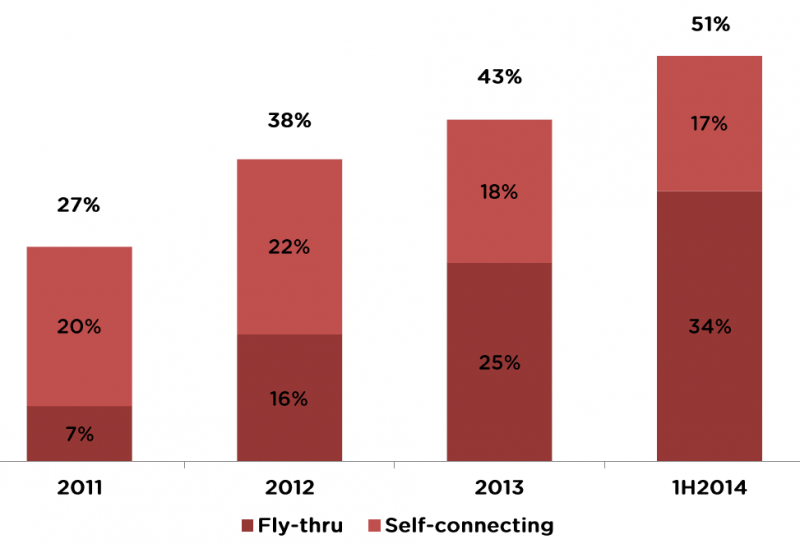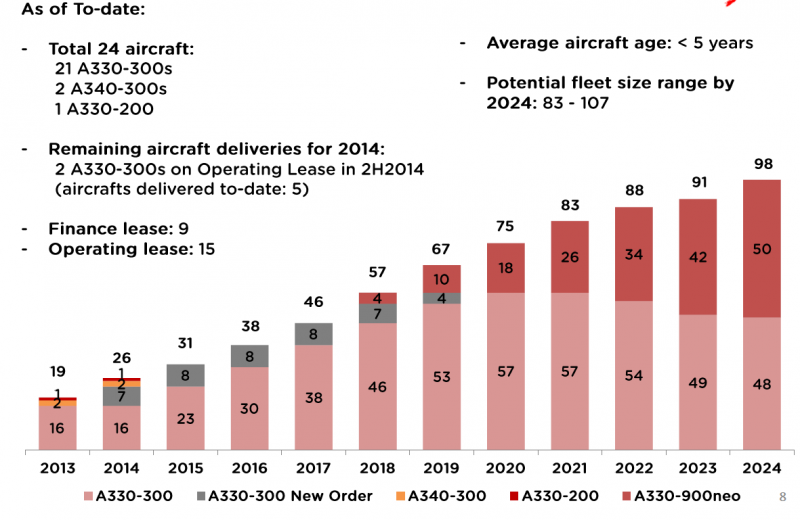AirAsia X records 2Q2014 loss as Australia underperforms. But long-term prospects are still bright
AirAsia X incurred a large loss in 2Q2014 driven by a weak performance on Australian routes, where large capacity gains from 2H2013 continue to impact yields. The MYR129 million (USD40 million) loss for 2Q2014 marks the third consecutive quarter of losses for AirAsia X, which has seen its stock price slip by over 30% since its Jul-2013 initial public offering.
But the long-haul low-cost carrier group expects significant improvements in 2H2014 as the rate of capacity growth slows in its core Malaysian market, allowing for the capacity added over the past year to be absorbed. AirAsia X is also reducing capacity slightly on two of its weakest routes, Sydney and Perth, a sensible move given the market conditions in Australia.
While the losses have been disappointing, strategically AirAsia X has improved its position significantly over the last year. The group has established two new joint ventures and is gaining market share in key medium-haul markets from Malaysia, putting it in an enviable position as rival Malaysia Airlines (MAS) struggles and restructures.
AirAsia X operating margin slips to negative 19% in 2Q2014
AirAsia X reported on 19-Aug-2014 a MYR129 million (USD40 million) net loss for 2Q2014 compared to a net loss of MYR32 million (USD11 million) in 2Q2013. The loss is significantly larger than the loss of MYR11 million (USD3 million) in 1Q2014 and the loss of MYR87 million (USD28 million) for the full year in 2013. AirAsia X was profitable in 2010 and 2012 - albeit very modestly - while in 2011 it was also in the red.
The group's operating loss increased from only MYR12 million (USD4 million) in 2Q2013 to MYR130 million (USD40 million) in 2Q2014. AirAsia X recorded an operating (EBIT) profit margin of negative 19% and a net margin of negative 23%. In both cases the margins represented an alarming 17ppts drop from 2Q2013.
AirAsia X financial highlights: 2Q2014 vs 2Q2013
Revenues in 2Q2014 were up by 37% to MYR672 million (USD208 million) but RPKs were up at a faster clip, 44%, as AirAsia X had to cut fares to stimulate demand. ASKs were up by 47%, resulting in a slight reduction in load factor.
Revenue per ASK was down 7% year over year while the average fare per passenger dropped by 24%, an indication of the intensifying competition and the need to price aggressively to fill the additional capacity.
AirAsia X operating highlights: 2Q2014 vs 2Q2013
AirAsia X incurs USD32 million loss on Australian routes in 2Q2014
AirAsia X has had to be particularly aggressive in Australia, where it increased ASKs by 77% year over year. Revenues on Australian routes however increased by only 32% in 2Q2014 compared to 2Q2013. As a result RASK on Australian routes dropped by 23%.
AirAsia X recorded a loss before tax on its Australian routes of MYR104 million (USD32 million), which was about quadruple the loss of MYR25 million (USD8 million) in 2Q2013. Its loss on North Asian routes also widened, but relatively modestly, from MYR33 million (USD11 million) in 2Q2013 to MYR50 million (USD16 million) in 2Q2014. On other routes, which currently only include Colombo in Sri Lanka and Jeddah in Saudi Arabia, AirAsia X had a MYR22 million (USD7 million) profit in 2Q2014 compared to a break even result for 2Q2013.
The EBITDAR margin on Australian routes was an unsustainable negative 24% in 2Q2014 compared to a positive 10% in 2Q2013. North Asia remained slightly profitable on an EBITDAR basis.
AirAsia X segment profitability: 2Q2014 vs 2Q2013
AirAsia X CEO Azran Osman-Rani said during the group's 2Q2014 results presentation that some Australian routes were softer than expected, particularly Sydney and Perth. Mr Azran is confident the carrier's performance in Australia will improve, pointing out that ASK growth to Australia will moderate on a year over year basis to about 25% in 3Q2014 and be flat in 4Q2014.
Market conditions in Australia remain challenging
As AirAsia X has not added capacity to Australia since its huge growth spurt in 2H2013, when it nearly doubled capacity, it should have an opportunity in 2H2014 to improve revenues and yields. But market conditions at the start of 3Q2014 remain challenging, which could delay AirAsia X's hopes for a recovery. While capacity levels in the Australia-Asia market have started to moderate, demand has not been growing.
AirAsia X's head of commercial for Australia, Stuart Myerscough, acknowledged during the 7-Aug-2014 CAPA Australia Pacific Aviation Summit that demand for services to and from Australia has softened in recent weeks, particularly outbound demand from China. "We have a lot of competitive pressure as well as market demands which can fluctuate. We've seen that in the last couple of months - a bit of fluctuation in the market, which puts further pressure on everyone that is operating and trying to grow - and within the last few weeks as well."
AirAsia X's expansion in Australia however is clearly strategic and the airline is prepared to weather the storm even if that takes a few more months. "You need to get through growth spurts to get the scale, to operate successfully and survive in the long run but those growth spurts do really put a lot of pressure on the bottom line," Mr Myerscough told the CAPA Summit.
In an interview with CAPA TV after speaking at the Summit, Mr Myerscough added: "There's a lot of additional capacity and it's still being absorbed in some markets. We are starting to see some signs of overcapacity in some markets in Australia and other markets within Australia are absorbing it quite nicely. It is going to take a little bit of time to let the market reset and settle down."
AirAsia X head of commercial for Australia Stuart Myerscough discusses the market conditions in Australia, the role of transit traffic in AirAsia X's Australia operations and the prospect of flights to Australia from the group's new affiliates in Indonesia and Thailand
AirAsia X to reduce Australian weekly flights from 54 to less than 50
AirAsia X currently operates 54 weekly flights to Australia, including 14 each to Melbourne, Sydney and Perth, seven to Gold Coast and five to Adelaide. On an ASK basis Australia accounted for nearly half of the carrier's capacity in 2Q2014 compared to about 40% in 2Q2013.
AirAsia X focused in 2H2013 on expanding in Australia following a breakthrough in Australia-Malaysia bilateral talks, which increased by 50% the total available capacity to the four main gateways (Sydney, Melbourne, Perth and Brisbane). AirAsia X responded by adding a second daily frequency to Sydney, Melbourne and Perth. It also upgraded Gold Coast to daily and launched Adelaide. (There are no capacity restrictions to Gold Coast and Adelaide as they are designated as open skies airports.)
See related report: AirAsia X emerges as Australia's fourth largest foreign airline, overtaking rival Malaysia Airlines
The capacity added to Australia was too much for the Australian market to absorb without significant reduction in fares, particularly given it came at a time when MAS and some other Southeast Asian airlines also added capacity to Australia. MAS used newly available traffic rights to introduce third daily flights to Melbourne and Sydney.
AirAsia X is not planning to mount any additional flights to Australia in 2014 or 2015, which should allow the carrier to eventually restore RASK to 1H2013 levels. In fact AirAsia X is slightly cutting capacity to Sydney and Perth. Mr Azran said both routes will be served with 11 to 12 weekly flights for the rest of 2014 and 1H2015 with the exception of certain peak travel periods when double daily service will be restored.
AirAsia X is reallocating the capacity to pursue charter opportunities and to increase services to China during peak periods, including during Chinese New Year. "We are managing capacity much more tactically now," Mr Azran said.
AirAsia X could benefit from MAS adjustments in Australia
Mr Azran is also encouraged by signs that AirAsia X is improving its market share between Australia and Malaysia despite not increasing its capacity share. He told analysts that AirAsia X's passenger share in the Australia-Malaysia market is now approximately 50% although its capacity share is only about 40%.
In Melbourne and Sydney AirAsia X claims to be the market leader although it currently has one fewer daily frequency than MAS. AirAsia X says its load factor is about 79% on Melbourne and Sydney while MAS' load factor has been in the mid 50s to mid 60s.
MAS has been pricing very aggressively in the Australia market and in many cases has been offering lower fares than all competitors including AirAsia X. But AirAsia X does not believe the aggressive pricing has translated into strong load factors and as a result MAS has been losing market share. As CAPA has previously analysed, the aggressive pricing strategy from MAS began in 2013 - long before MH370 or MH17, which have compounded the Malaysian carrier's problems.
AirAsia X has not noticed any capacity adjustments by MAS in any of their overlapping markets with the exception of Beijing, where MAS has cut one of its two daily flights. But more cuts at MAS, particularly in Australia, are inevitable as the airline starts to implement its restructuring plan.
AirAsia X however can't bank on changes at MAS improving its fortunes. MAS could end up focusing capacity cuts on routes where it does not face competition from AirAsia X. MAS is also hardly its only competitor in Australia or any of its other markets. In fact AirAsia X is now competing against a much wider group of airlines in Australia - and overall - as it has evolved into a network rather than point to point carrier.
AirAsia X reaches 50% transit traffic milestone
Transit traffic accounted for 51% of total AirAsia X traffic in 1H2014, the first time AirAsia X (or almost certainly any LCC in the world) has exceeded the 50% market. An increase in transit traffic from AirAsia X's five Australian routes has been a big driver of the overall increase in transit traffic as additional frequencies have opened up more connection opportunities. The 76% increase in ASKs to Australia over the past year also clearly could never have been absorbed by the local Malaysia-Australia market.
AirAsia X transit traffic component: 2011 to 1H2014
As CAPA has previously analysed, transitioning from sum of sector to origin and destination pricing model has helped enable the rapid growth in transit traffic. AirAsia X also has started working with global distribution providers and online travel agents, which now account for 9% of total bookings.
See related reports:
- AirAsia further slows fleet expansion as 1Q profit falls - with the potential to accelerate later
- AirAsia X drives 43% transit traffic at Kuala Lumpur's KLIA. Can Singapore follow the same recipe?
Mr Azran said the combined AirAsia and AirAsia X revenue management team has now moved completely to origin and destination pricing to improve competitiveness. He added that AirAsia X is also continuing to work on adding more online travel agents.
AirAsia X has particularly focused on growing traffic in the Australia-North Asia market, where it competes against a wide range of Asian carriers as well as Qantas and Jetstar. Currently North Asians account for a small although growing share of AirAsia X passengers on flights to and from Australia. (Currently 50% of its passengers on Australian flights are Australian citizens, 30% are Malaysian citizens and 20% are other nationalities. Of the Australians, 70% connect beyond Kuala Lumpur, mainly to domestic destinations and regional international destinations within Southeast Asia.)
AirAsia X now has about a 15% share of the indirect Australia-North Asia market, up from about 5% in 1H2013. Mr Azran expects this to reach about 20% by the end of 2014 as AirAsia X adds flights to Seoul and Tokyo, improving connections in the Australia to Korea and Japan markets.
AirAsia X focuses expansion on North Asia
AirAsia X recently increased Kuala Lumpur-Seoul from seven to 11 weekly flights and plans to have a double daily service to Seoul by the end of 2014. It also plans to increase Kuala Lumpur-Tokyo Narita, which it launched in May-2014 with four weekly flights, to daily by the end of 2014.
Narita became AirAsia X's fourth destination in Japan, joining Tokyo Haneda, Nagoya and Osaka. Nagoya was only added in Mar-2014 and is currently served with four weekly flights.
North Asia routes performed much better than Australian routes in 2Q2014 with the drop in RASK driven primarily by Nagoya, where the airline incurred large losses as the route was just starting. AirAsia X also saw year over year RASK drops in Chengdu and Osaka as both routes were recently upgraded from four weekly flights to daily. AirAsia X expects improvements in these markets as well as in Nagoya in 2H2014 as the capacity added becomes fully absorbed.
Mr Azran said the carrier's Chinese routes performed well in 2Q2014. Xian, which was launched in Jul-2014 and is the fifth AirAsia X destination in mainland China, has also been "ahead of our expectations". AirAsia X has noticed a significant volume of passengers travelling from Xian to Australia and Bali.
AirAsia X is generally bullish on opportunities in the Malaysia-North Asia market. In addition to allocating all the additional capacity in 2H2014, North Asia will be allocated all of additional capacity at the Malaysian operation in 2015.
AirAsia X already recently announced Chongqing as its sixth destination in China, with four weekly flights beginning in Feb-2015. Mr Azran said AirAsia X is looking at launching one or two additional new destinations from Kuala Lumpur in 2015 for a total of two or three - all of which will be in North Asia. Mainland China is the most logical market to see further network growth given AirAsia X's recent success in China and the fact the carrier already serves two destinations in South Korea and four in Japan as well as Taipei in Taiwan.
AirAsia X sees China demand hold up despite MH370 incident
AirAsia X has not noticed a drop in Chinese traffic due to the MH370 incident, which has significantly impacted outbound China demand at MAS and other Southeast Asian airlines. AirAsia X says the portion of their Chinese passengers that have Malaysia as a final destination has stayed constant at about 40%. AirAsia X could be benefitting from Chinese passengers avoiding MAS, enabling it to keep its traffic figures constant despite the sharp drop in total Chinese visitor numbers in Malaysia. Unlike other airlines in the Chinese market, AirAsia X also does not rely heavily on group passengers, which is where most of the declines have come.
Overall AirAsia X is in position to benefit as MAS and other Southeast Asian carriers restructure. How deep and where MAS cut is still an open question. AirAsia X would benefit significantly from MAS cuts in North Asia and Australia. But MAS could view these as strategically important markets. MAS also has a large domestic and regional international operation, where it expanded significantly in 2013, as well as a long-haul operation to Europe.
But regardless of how much AirAsia X benefits from cuts at MAS, the group's position should improve. AirAsia X's performance likely reached a low in 2Q2014. Improvements are expected in 3Q2014 and particularly 4Q2014. For the full year AirAsia X is still expecting to record an improvement in RASK, with a gain in 2H2014 offsetting the decline in 1H2014.
The last year has been about strategic growth so the losses are not surprising, particularly given the unfavourable market conditions in Southeast Asia. AirAsia X grew its fleet by 64% from 14 to 23 aircraft from the end of 2Q2013 to the end of 2Q2014.
The group recently took delivery of its 24th aircraft and currently has a fleet of 21 A330-300s, one A330-200 and two A340s. The original carrier in Malaysia currently operates scheduled flights to 18 destinations using 19 A330s. It also still has two A340s which have been contracted out on charters or wet leases until 2015, when they are due to be returned to Air Canada. (The A340s were delivered in 2009 and used to serve Europe until London and Paris was dropped in 2012.)
TAAX sees high initial load factors; IAAX closes in on launch
Two of the group's A330s are currently at joint venture Thai AirAsia X (TAAX), which commenced charter flights in Apr-2014 and scheduled operations in Jun-2014. One A330-300 is currently at start-up Indonesia AirAsia X (IAAX), which recently completed proving flights and plans to commence operations by the end of 2014. Mr Azran said during the 2Q2014 analyst call that IAAX is now in the final stages of its application for an air operator's certificate and should soon secure final approval from the Indonesian DGAC.
In 2Q2014 AirAsia X recorded losses of MYR19 million (USD6 million) related to its 49% stakes in TAAX and IAAX (without providing a breakdown). AirAsia X stated that TAAX's first scheduled route, Bangkok-Seoul, has performed well with average load factors so far of 88%.
Mr Azran said TAAX has been able to attract a surprisingly high number of Thais on the Bangkok-Seoul route, which accounted for about 60% of total passengers since the service began two months ago. This has helped fill up the initial flights despite the relatively weak inbound demand given the political instability in Thailand.
Mr Azran added that Thais have also accounted for 70% of passengers who have so far booked on the new Bangkok to Tokyo and Osaka routes, both of which are launching on 1-Sep-2014. AirAsia X believes Japanese point of sales will increase as the Japanese market becomes familiar with the TAAX service. Thailand's inbound tourist market is also starting to recover, providing more favourable market conditions for TAAX and long-haul LCC competitor NokScoot, which plans to launch in 4Q2014 and compete with TAAX in the Thailand-North Asia market.
See related report: Nok Air's outlook improves after a challenging 2Q2014 as Thailand stabilises and NokScoot launches
Mr Azran said TAAX has been allocated three additional A330-300s in 2015, including two in 1H2015 and one in 1H2015, for a total of five aircraft. The carrier will likely again be allocated three additional A330-300s in 2016.
TAAX plans to initially focus on the North Asia market. Mr Myerscough said in the CAPA TV interview that Australia could be launched in a later phase, perhaps in 18 to 24 months.
Australia is the initial target market for IAAX, with flights from Bali to potentially both Melbourne and Sydney to be launched at about the same time. IAAX is expected to launch in 4Q2014 with just one aircraft. But a second A330 is slated to be delivered to IAAX in early 2015 followed by a third aircraft in mid-2015 and potentially a fourth aircraft in late 2015. IAAX is also expected to be allocated two to three aircraft in 2016.
AirAsia X fleet grows rapidly
The group overall is committed to eight A330-300 deliveries in 2015. For now three are allocated to TAAX, two or three to IAAX and two or three to the original unit in Malaysia. The Malaysia aircraft will be used to launch Chongqing and one or two other new destinations in North Asia. The group also plans to return both its A340s and its lone A330-200 in 2015, giving it an all A330-300 fleet consisting of 31 aircraft at the end of 2015.
AirAsia X fleet plan: 2013 to 2024
The group's fleet is slated to grow by another seven aircraft in 2016 and by eight aircraft in 2017. AirAsia X says from 2018 it will have flexibility in its order book to accelerate or slow down growth depending on market conditions. The launch of a potential fourth or fifth base, which is not expected within the next few years but could be opened by early next decade, is another important variable.
The flexibility enables AirAsia X to spool up to as many as 107 A330s by the end of 2024 or as few as 83 if market conditions are not favourable. The flexibility was gained as part of its Jul-2014 deal for 50 A330neos, which gives AirAsia X the option of not taking its final batch of A330ceos. The A330ceos which AirAsia X may not end up taking are currently slated to be delivered in 2018 to 2020 alongside the first batch of A330neos.
AirAsia X also has the flexibility to return some of its older A330ceos as their leases expire. AirAsia X has been selling and leasing back almost all of its recent A330 deliveries and plans to put on operating leases at least seven of its eight deliveries slated for 2015. This is being pursued partly in order to preserve cash but also because operating leases give it the flexibility to return the aircraft in 10 to 12 years and replace them with A330neos.
For now the group envisions a fleet of 98 A330s, including 50 A330neos and 48 A330ceos, by the middle of next decade, although again this can potentially go up or down by 15 aircraft depending on market conditions. As CAPA previously suggested, the 100-aircraft mark will likely be reached around the middle of next decade.
See related reports: AirAsia X reinforces position as long-haul LCC leader with 50 commitments for A330neos
For now AirAsia X excludes in its new 10-year fleet plan the 10 A350s the group ordered several years ago. Mr Azran explained during the 2Q2014 analyst call that AirAsia X now has the flexibility of deciding just prior to the scheduled first delivery in 2018 whether to take the 10 A350s or instead take A330neos. He added that A350s could still potentially be acquired as a niche fleet for European services. But as it does not have to make this decision for another four years they are not in the current fleet plan. This gives the airline the flexibility to review how the A350 is performing after entering service as well as relook at its long-term network requirements.
At least for the time being AirAsia X seems content on sticking to medium-haul services within Asia Pacific. The focus is to grow by using the new joint ventures to connect the dots while continuing to expand from Malaysia by adding destinations in countries already serviced, predominately China.
AirAsia X has challenges but huge potential as it tries to turn the corner
The fleet and network strategy is sensible and not overly ambitious given the huge opportunities in medium-haul markets within Asia-Pacific. AirAsia X had the lowest unit costs in the industry and has become a true network carrier, with half its passengers transiting to destinations beyond Kuala Lumpur.
AirAsia X also has the potential to expand its premium business as it leverages its new home at KLIA2, which provides a much improved passenger experience, and adds lounge access as part of its package for premium passengers. For now it is sticking to a small 12-seat business class cabin, which accounts for only 5% of total seats and 8% to 9% of the group's total revenues. But there should eventually be opportunities to expand its business class cabin, particularly as MAS downsizes. The upcoming rebranding of the AirAsia X premium product should further generate demand, although the actual product (which is already lie-flat) or configuration will not change.
AirAsia X still faces huge challenges, but for the most part the challenges AirAsia X is starting to present to full-service carriers throughout Asia are a lot harder to overcome than the challenges AirAsia X faces itself. Certainly AirAsia X needs to start making profits and prove to a rather sceptical investment community that the strategic growth pursued over the past year was the correct strategy.
Profitability is unlikely to occur in 3Q2014 as market conditions remain difficult. But barring any unexpected upheaval in the market AirAsia X figures should start to gradually improve.
AirAsia X has already succeeded at shaking up the Asian industry. Long-term success in the aviation industry is never a sure thing. But despite the rather dismal recent performance its prospects are bright.
